So you want to solar panel?

We recently decided to get solar panels, and as always I dove into this subject with enthusiasm. Here’s a short recap of what I learned.
We live in an old house, built in the 1920s. Last year we had new tiles installed on our roof, and we decided it was not profitable to install solar panels. Plus we were really happy with the look of our new roof!
That was July 2021.
Fast forward to February 2022: we get our new energy contract and the prices of gas and electricity were more than doubled! And now with the horrible war on Ukraine (fuck Putin, donate here ), we are trying to reduce our reliance on Russian gas and invest in new energy sources. Conclusion: we need solar panels!
I investigated the hell out of our solar panels, so I hope this information is useful for other people also.
Side note: solar panels are also a good investment to reduce the effect of climate change. This is another important reason for us to get them, but for this article I’m only looking at the finances of solar panels. If climate is important for you, also take a look at my other article with tips to save on gas .
From my calculations I can see solar panels are one of the best investments you can make. You get your money back within six years, and then get “free money” for another twenty years.
But the profitability depends a lot on your situation. Much more than the technology you choose or initial costs of installation!
There are two factors important here:
- Your energy consumption
- The available space for panels
1.1 your energy consumption #
We are a family of four and use 3.400 kWh per year (you can find your yearly usage on the ‘jaarnota’ of your power company). We expect this usage to go up when our kids grow older. Long term plans (5+ years) include switching to electricity for heating, and an electric car.
Why is your energy need important? Any power surplus we generate with our solar panels is profit, right? 🤑 Well, yeah, but less than you might think! It’s more beneficial to use the energy from your panels yourself instead of delivering back to the net.
Example: “The two-day-year” #
Let’s do a quick calculation with a completely unrealistic example 😃
What if a year lasts only two days and each day we consume 10 kWh. Our two-day-year has a winter day and a summer day. In the summer we get 20 kWh from our solar panels and in the winter only 5 kWh. That means we generated 25 kWh and used 20 kWh during our two-day-year: 5 kWh profit, yay! 🎉

But our energy generation was uneven: during the summer we had a surplus that we sold to the power grid and in the winter we had to buy electricity.
In the Netherlands we have the ‘salderingsregel’ which means we use the grid as a battery; ‘storing’ our surplus from the summer for free and using it in the winter (or more accurately: we sell energy to our power company for the same price as we buy it). But this law only applies for energy we consume in the same year. Our 5 kWh ‘profit’ is sold back to the grid for a much lower price, less than half of the price we pay for electricity.
This law will not last forever, it’s planned to be dismantled over the next 9 years. We need a solution for that, and luckily there is one: home batteries. Although too expensive right now, the battery efficiency is increasing like crazy and prices are dropping.
If you have a lot of panels and generate more than you consume, a return on investment takes much longer, or maybe your panels not profitable at all.
Note that energy-companies implement the salderingsregel differently , and the same holds for the price of energy bought back (terugleververgoeding). It’s good to use a compare website for your next contract!
How much electricity should I generate, then? #
Although over-producing seems like a bad idea based on my quick example above, it’s not that black and white. A ‘longer time to get return on investment’ doesn’t mean ‘no return on investment’, it might still be worth installing over-capacity even if it means those solar panels get a 10 year ROI instead of 6 years. Plus, your electricity consumption is likely to go up and electricity prices as well. If you have the money to invest, I think it’s profitable to install as many panels as you can.
1.2 available space for panels #
We have a traditional roof with two angled sides, one facing northeast and the other facing southwest.
We asked three companies to make us an offer, and all three came with wildly different layout plans for the panels. One placed just six on the southwest side, the other placed twelve total: six front and six back, the last one made a mosaic by creatively placing 10 panels facing southwest (it looked really ugly).
The average costs per solar panel has decreased by 91% since 2010, and the efficiency is still increasing. This means that even solar panels in bad positions such as shade or facing north generate enough power to be profitable. I could see this in my calculations, panels from five years ago were not profitable in such positions, but newer ones are, especially with the ‘salderingsregel’.
My initial doubts about the panels facing north-east were taken away, and so we chose the 12 panels-layout.
You can easily make a plan for solar panels on your roof using Solaredge designer (see later in the article), or simply drawing on paper. You’ll probably know the width and depth of your house, if you also want to know the height of your house you can easily find that in 3D BAG.
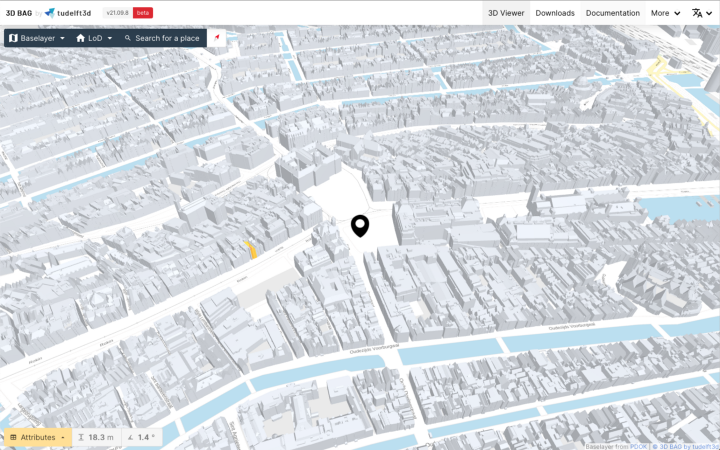
Your solar installation consists of two parts, solar panels and an inverter:
2.1 Solar panels #
There are loads of options for solar panels. You can integrate them into your roof, or replace your roof tiles with solar powered ones. We went for the default ‘big black panels installed on top of the tiles’, because we already re-tiled our roof and at the time we couldn’t find a contractor who did the other options for existing houses.
There’s another choice to make: percium versus full-black. The percium types have a higher performance on hot days, because they don’t heat up as much in the summer. Solar panels reach temperatures up to 50 degrees and that leads to a degradation in efficiency. Still, we decided on full-black as they look nicer.
Solar panels are measured in Wp, the amount of watts they give in laboratory conditions. Higher Wp is better, but a higher Wp may also just be a bigger panel, as there is no uniform size. Most panels sold now are between 370 and 400 Wp. This was 295 Wp in 2017, and 330 Wp in 2019.
As for the difference in quality per brand? According to the experts you can’t go wrong with any type of panel; they are all good. There are some differences in efficiency, here’s a real-life test of recent panel types..
We went for 385 Wp Trina panels as those were the ones offered by our chosen supplier. Had we upgraded to 400 Wp panels, we would have expected a 118 kWh increase per year in production (including loss to shading etc), or an estimated 45 euro per year at the current prices. If every panel was 50 euro more expensive, it would take us 12 years to recoup, worth it if you are a long-term investor!
2.2 The inverter #
Your brand new solar panels need to be connected to your house and the power grid to do anything, and for this they need to be connected to an inverter.
An inverter converts the DC power coming from your solar panels to AC power. Some suppliers with a sense of drama call the inverter the ‘heart of the installation’.
A term you’ll see mentioned in other places with respect to inverters, is DC/AC oversizing. Your solar panels deliver a certain theoretical kWh per year, and you should get an inverters that matches that production. However, it’s possible to match the theoretical DC-output of your panels with a smaller inverter. So get 4200 kWh solar panels and buy a 3800 kWh inverter, for example. This has three advantages: the smaller inverter starts producing power earlier in the morning and goes on longer in the evening (smaller inverters need less power to ‘start up’), it is more efficient (3% loss at maximum power, versus 5,5% loss at half-power) and smaller inverters are cheaper. You aim for 80%-90% oversizing, but can go down to 70%. Of course, you might lose some power on extremely sunny days, but the effect is small as your solar panels are less efficient then (due to the heat).
There are three setups for inverters to choose from: string, string with optimizers and micro-inverters.
2.2.1 String inverter (serial) #
The simplest and cheapest solution is to put all solar panels on one ‘string’, just like the lights on a Christmas tree.
With this solution your panels are all connected to each other and to a single inverter inside your house. The inverter is easy to reach if you need to replace it (you can expect to replace it after 10–15 years) or want to upgrade it for a newer one with more features.
Furthermore, it’s easy to connect a battery to this system. Batteries work with DC-power, and the inverter can charge the battery immediately from the Solar panels.
For most situations this is great.
The single string solution has some drawbacks. Remember that it’s just like a Christmas tree lights: if one lamp breaks, al the lights go out. Something similar happens to solar panels in a string, albeit not as rigorous. If one panel breaks, the others still work. But if one or more panels perform badly, this affects the whole group. If there is shade (like trees or a chimney) or if the panels are on different roofs, then the efficiency of the entire system goes down rapidly.
This is usually explained as follows: “if one panel is at 80% efficiency because a tree blocks the sun, all panels run at 80% efficiency!”. That’s not how it works. When one panel performs badly, it will shut itself off (not really by design, it’s a technical property of the ‘bypass diodes’ in the system). If you have a system with 10 panels, where one has shade and is working at 80%, then the whole system will perform at 900% (9x100%, 1x0%). If in the same system there are four panels with 80% efficiency due to shade, the system ‘decides’ not to bypass these four panels and instead let all panels works at 80% efficiency (10x80%=800% is better than 4x0%+6x100%=600%).
If there is a chance that one or more of your panels has a lower production than the others, take optimizers or micro inverters (see next paragraphs).
Another drawback is that a serial setup means running a lot of DC-voltage over your roof. This is perfectly safe when installed correctly, but it gave me a bad feeling. DC-voltage is more likely to cause a fire than AC voltage.
Inverters can also give off a buzzing sound, although I’m assured the newer ones make almost no noise anymore.
2.2.2. String inverter with Solaredge optimizers (serial) #
One solution for shade in a serial system is to use optimizers. These small devices are attached to each solar panel and they do some magic to the power distribution.
With optimizers, shadow on one panel doesn’t influence the other panels anymore. If one solar panel has 80% efficiency, the others can still run at 100% efficiency. You still have all the benefits of having a inverter indoors.
It’s more expensive, of course, but even if you have only a little bit of shade, this extra price is definitely worth it. Optimizers also add a bit of extra security: they bring the power down on the solar panels in case of an emergency.
The benefits don’t stop there. With optimizers you have insight into the power generated per panel, Solaredge has a nice mobile-app and the system can integrate with home automation. Plus there’s 25 years warranty on the optimizers! (their inverter typically has 12 years warranty, but is extendable)
The downside is that optimizers are finicky to work with. Your setup has to be just right, otherwise you risk losing efficiency in your output. Have less than six panels? Your optimizers won’t perform right! Picked the wrong optimizers for your panels? They don’t work right. Panel layout spanning multiple roofs facing different sides? Be sure to pick the right optimizers, or… it won’t work right!
I strongly suggest reading through this thread for more info and modeling your planned layout in Solaredge Designer (more on the tool later!). With this tool you see which optimizers you need and if there will be any loss in efficiency.
Every offer with optimizers I got had something wrong with it when I checked it in Designer:
Example 1: a proposed layout plan had only six panels on a string and 60V optimizers, but this string is too short for this type of optimizer and Designer gives a warning. We can add two more panels on this string, or use 85V optimizers.
Example 2: another offer had under-powered optimizers, which Designer doesn’t even allow
Optimizers are a beautiful solution and Solaredge has a really nice ecosystem. When you double-check your installation in Designer, you can have a system you are happy with. Their apps are highly rated on the App Store, 4,5 stars.
But we decided to go for option number three…
2.2.3. Micro inverters (parallel) #
Micro-inverters are exactly what they sound like: a lot of small inverters, instead of one big inverter. Each panel gets its own inverter attached, and the resulting AC voltage goes into your house where you can use it.
That’s it.
Because every panel has its own inverter, they all operate independently. It’s a parallel system. It’s elegant and simple. Shade on one solar panel does not influence the other panels. A panel or inverter breaks? The others will continue their duty. Plus you can see the energy-production per panel, just like Solaredge. A potential downside is that more inverters means more ‘points of failure’, and if one of them breaks, you’ll have to get out on the roof!
There are two brands to consider: Enphase is the leading brand and APSystems is the runner up. Both APSystems’ and Enphase micro-inverter are rated as very good. There were some problems with the reliability of micro-inverter in the past, but that’s all water under the bridge. They both offer 25 year warranty: Enphase by default, for APSystems you pay extra to extend the default 12 year warranty.
Enphase has a rich ecosystem. They make their own batteries, they integrate with a lot of other systems, they make nice apps (their app is rated high with 4,6 stars). It’s all great, until you look at the pricing. Very expensive.
APSystems found a smart way to reduce their pricing. They have one micro inverter per two panels, with some optimizer-like functionality per panel. This means they are much cheaper than Enphase, and sometimes even cheaper than a Solaredge system. The downside is they have a much less developed ecosystem. They are ready for battery-integration, but don’t have such a system in place yet. Their app is rated very poorly, with 2,6 stars, but I disagree with these nay-sayers and the app is actually quite sufficient.
So what is the price difference between Enphase and APSystems? Well, on our offer Enphase was 10% more expensive, or 550 euro. And that was with undersized Enphase-micro-inverters. It was a hard-choice, but we decided we trust APSystems to get their ecosystem in order in the coming 5 years and we took our 550 euro to spend it elsewhere. The bad app is an inconvenience, but I expect to get bored with looking at my solar panel production quickly, and the panels will produce energy without the app just fine.
Note: there’s no real-advantage for a system with micro-inverters to integrate with a home-battery. Of course we only want to charge our home battery with solar-panel-energy, but we can achieve this with any system that can connect with our ‘smart meter’. This differs from serial-systems with a central inverter: if you connect a battery straight to the inverter it can charge this battery immediately with DC-energy of the panels without conversion loss.
Step 3: Money talks 🤑 #
If you want to know how much money you make with the panels, you’ll need to know how much power will your new panels generate in a year.
There’s a simple trick to calculate this if you live in The Netherlands: you can approximate the theoretical production capacity by multiplying the ‘number of panels installed’ by the ‘amount of Wp per panel’. We installed 12 panels with 385 Wp, so we expect to generate 4.560 kWh per year under ideal conditions.
But, we don’t have ideal conditions. The panels aren’t facing the sun at an ideal angle, the panels perform worse when it’s warm, there can be clouds, the wires and inverters loose power in transport, etcetera.
I’ve had many offers from different suppliers and their estimates vary wildly, from 3.200 kWh to 4.080 kWh for 12 panels, and 2.290 kWh to 3.430 kWh for 10 panels.
I decided to make my own calculations to see which layout-plan would give us the best generation of power. I was especially curious if the panels on the backside of our house facing northeast would generate enough kWh to be profitable.
Our preferred layout has six panels facing south-west in the front of the house, four panels facing north-east on the back, and two panels facing south on the ‘uitbouw’.
I used two programs to recreate our house and the shading conditions: Solaredge Designer and Sketchup/Skelion. Of these two, Solaredge is definitely the clear winner in user-friendliness.
If you just want to do a quick calculation, take your ‘theoretical capacity’ (see above) and use an efficiency of 70% for north facing panels and 80% for south. For a bit more detail I can recommend the calculators by Solar Bouwmarkt and Berekenhet . If you want to see how much sun you get, and where it comes from, take a look at Suncalc.
3.1 Solaredge Designer #
Even if you’re not thinking about using Solaredge, I can highly recommend playing around with their online Designer tool. It’s free and fun.
With Designer you immediately get a complete picture: the layout, the shading, the electrical setup, the investments needed and the time it takes to recoup that investment.
You can also export a CSV of the data per day if you want to do a full-analysis yourself (which I did, of course, see later).
The first thing you do in Designer is draw your house, some trees (for shading) and the solar panels. You then let Solaredge calculate the optimal string-configuration and inverter.
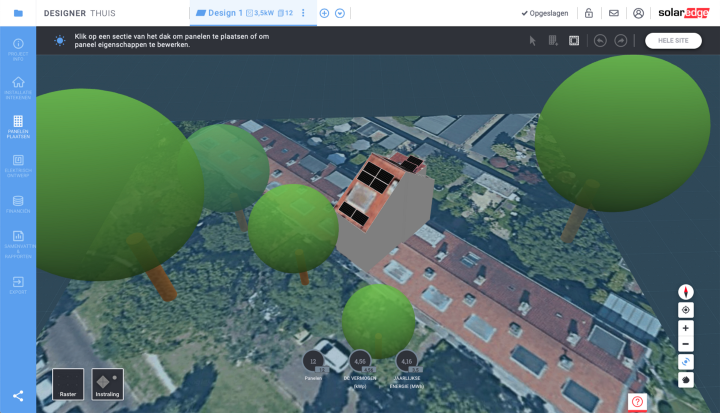
After that’s done, you get a detailed analysis of the expected returns:
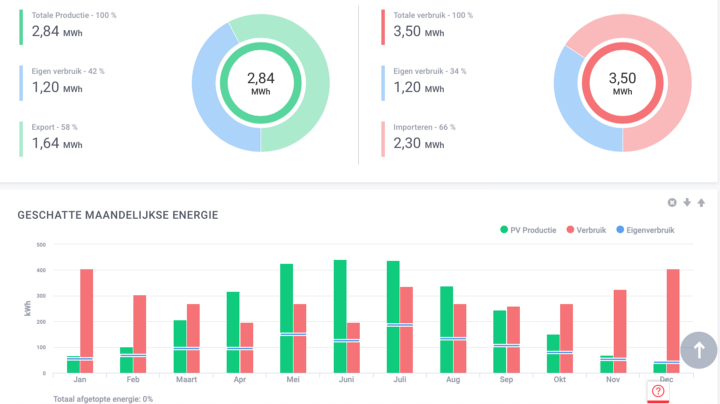
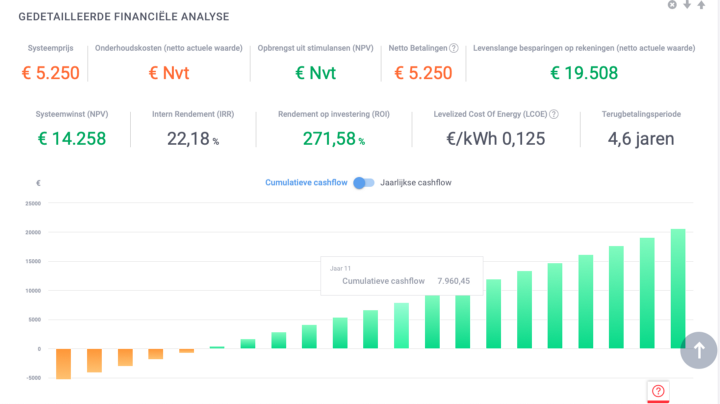
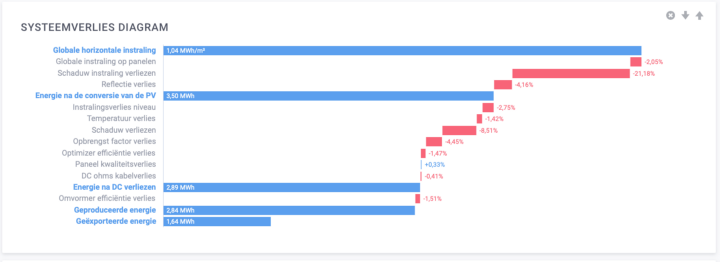
In the last image you see the drops in efficiency. The 4,5% “opbrengstfactor verlies” is a loss in conversion, as I had trouble getting the system ‘correct’. It may not seem as much, but that adds up over time!
As we will be using microconverters instead of Solaredge, I took out the 4,5% and I’m assuming a 2.950 kWh prediction per year. That’s a 65% efficiency which is very low compared to the other predictions. Still, Designer expects us to recoup our investment in about 5 years with the current energy-price (39 ct per kWh)!
The Solaredge report is very detailed, it shows temperature degradation, shading, orientation, etc. But sadly, I didn’t get a split per panel position, so I couldn’t answer my main question: is it profitable to add panels facing northeast?
Next tool!
3.2 Sketchup/Skelion #
Sketchup is a 3D-drawing tool that’s used a lot in architecture and other industries. It used to be free when it was owned by Google, but it is now a paid product with a very generous 30-day trial. Skelion is a plugin for Sketchup to draw solar panels, calculate shadow influences and do some advanced calculations.
I found the Sketchup/Skelion-combo very difficult in use and buggy.
The one thing Sketchup/Skelion had going for me is the ability to see the output split by panel, which I needed to see if the panels on the backside of the house were profitable.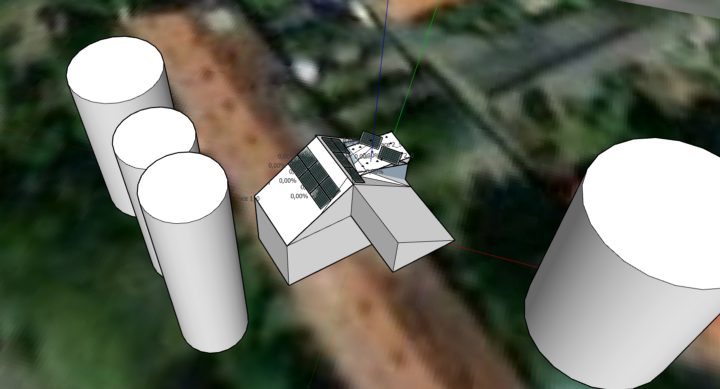
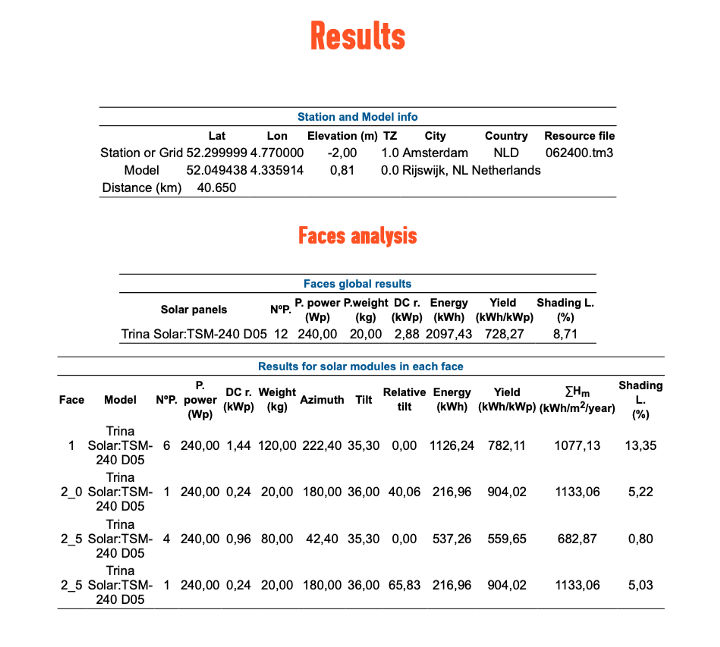
We can’t see the production immediately in Sketchup/Skelion like we could in Designer. We need another service for that: PVWatts. Luckily it’s integrated in Skelion.
The Sketchup/Skelion/PVWatts trinity expects a total 3077 kWh production per year, 66% efficiency. One percent more than Solaredge, but still not as much as my suppliers’ calculation of 3606 kWh (78% efficiency).
3.3 My own calculations 💪 #
I loaded all the data from the report Sketchup/Skelion generated with PVWatts into Apple Numbers. God, I love Apple Numbers. Plus, I used Calca to generate some quick reports of my own.
Here’s a quick yearly production graph I made based on the Skelion predictions, with our current yearly consumption added on top.
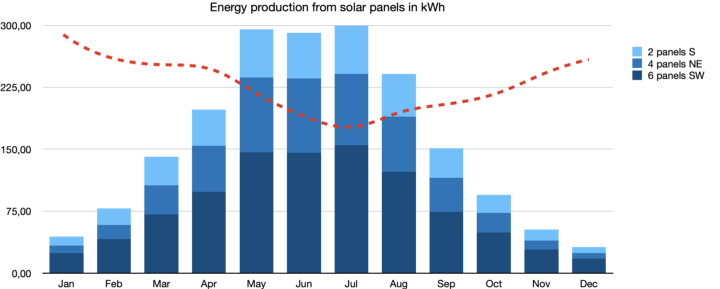
Using only 6 panels facing southwest would not be sufficient to generate enough power to fit the energy requirement even in the summer, so the back-facing panels are a useful addition.
Now let’s look at another graph with the effect of the panel-layout, how much does each panel-layout contribute to the total? As you can see, the 6 panels facing southwest are much more effective than the other panels. During the winter months the two panels facing south are more productive than the four panels facing north-east!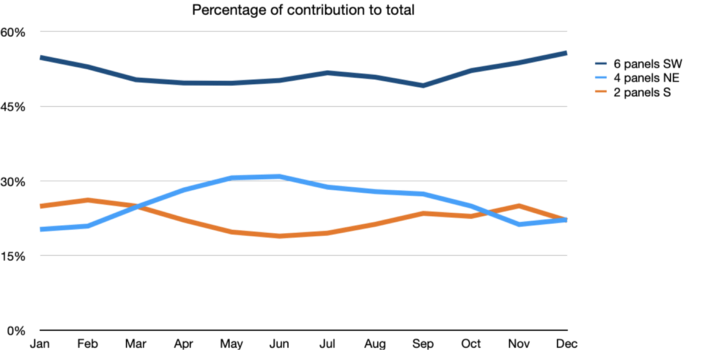
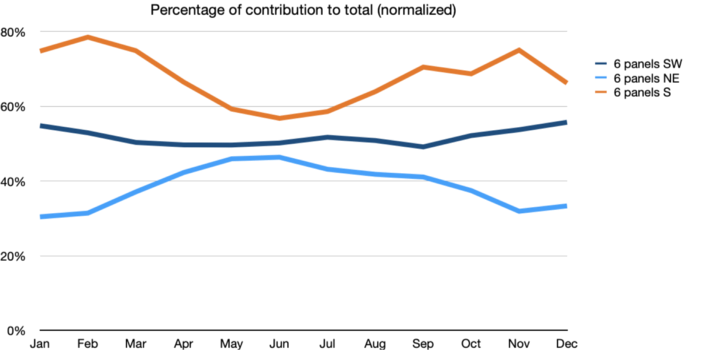
3.3.1 Daily production #
The real surprise comes when we look at daily production. For this I had to resort back to Solaredge Designer, because PVWatts doesn’t give a daily calculation. I made two systems in Designer, one with only six panels in the front of the house and one with our preferred layout of 12 panels. I then exported the CSV-data for both.
I took four days in the year, to represent the four seasons of the year:
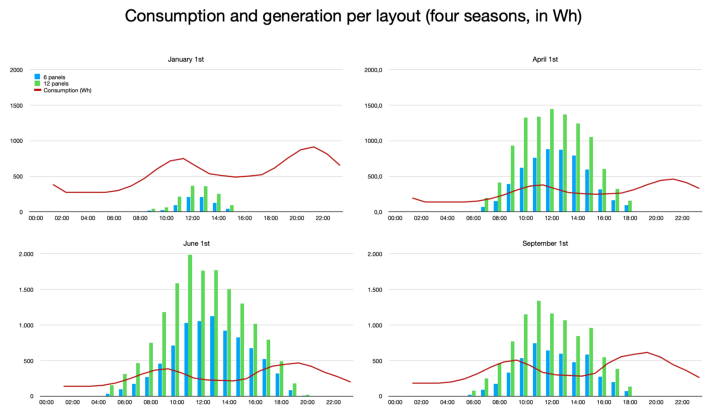
Interesting to me is that the 6-panel layout, facing only southwest, is already expected to generate some electricity in the early morning when the sun comes up in the east. The same holds for the panels facing north east during the day: there is not a huge dip in the green bars after 13:00 when the sun starts facing the other panels. I’m very curious if I will see this effect in my actual production. Solar panels generate power even when the sun is not shining on them!
Another very important insight is hidden in these daily graphs. Remember the ‘salderingsregel’ from the beginning of this article? That’s the Dutch law that states we can store all the energy we generate that we don’t use in the power grid for free, so we can use it at night and during the winter.
That salderingsregel will slowly be dismantlement over the next few years.
When the law is gone in eight years all the power production you see above the red line during the sunny hours of the day will be sold back to the net at a low price. The power we buy from the grid in the night we will have to buy back at a high price. So even though we have these awesome solar panels, there is a chance we will be paying for electricity again in the summer of 2030.
A partial solution is to get a battery to store our precious ‘free’ solar-energy. This will help us in the summer days, but it won’t help for the difference in energy production/consumption in winter versus summer. For that we need drastic measures like storing heat in the ground.
Is a mixed 12 panel layout better than a layout with all panels facing south?
If we had the space, we would have placed all panels facing south, instead of facing some north as we do now. That’s the most beneficial way.
But wouldn’t we be missing out on the ‘early morning sun’ this way? Out of interest, I checked how much better a 12 panel-layout facing both northeast and southwest performed versus the 6 panel layout facing only southeast.
We’d expect a 12 panel layout to always perform 200% better than a 6 panel layout.
Instead, what we see is the production dip below 200% between 10:00 and 18:00 for most days (when the northwest facing panels get no direct sunlight) and rise way above 200% in the mornings (when the southwest facing panels can’t see the sun).
A surprisingly big effect in the morning, and not too bad during the mid-day!
So maybe it’s a good idea to mix panels, so you can ‘catch’ some sun in the morning and evening?
Wrong! This is a case of misleading percentages. The production capacity in the morning is very low. If we look at the complete daily difference, we can very obviously see our 12-panel-mixed-layout never performs more than twice as good as our 6-panel-only-southeast-layout (January: 194%, April: 182%, June: 184% and September: 194%).
If you have the space, face all your panels to the ideal position: South!
3.4 Conclusions #
Our 12-panel layout, including northeast facing, makes a lot of sense versus only 6-panels facing southeast in our situation. Any added panel makes financial sense: the added cost of one extra panel on the whole installation is not that much. This is true until we start producing more energy than we consume per year because of the salderingsregel.
As we cannot see into the future, I have to keep a wide margin on the potential return-on-investment of the solar panels. I am assuming anywhere between 4–8 years for paying back our investment, and an additional 12–16 years of savings on the energy bill. This means between 14.000 to 18.000 euro profit on a 5.300 euro investment.
And that’s with a conservative 20 year life expectancy on the system. I’m expecting the panels to last up to 25 years!
Worth it!
Step 4: your turn? #
Solar panels are a great investment in my opinion. It’s a safe bet they’ll pay themselves back and then they’ll deliver savings on your energy bill for at least 15 more years.
If I got you interested in solar panels, your first step should be to go ask some offers from multiple companies (at least three different ones)!
I also advise looking at Solar-Bouwmarkt. You can buy exactly the equipment you want and have one of their local suppliers install it for a low price (or even install it yourself!). Solar Bouwmarkt will check your order to make sure you have everything, so it’s practically risk free. In the end, I decided against it because they are not selling APSystems, and an Enphase system was too expensive for me.
4.1 How do I know if I get a good deal? #
To know if the supplier gives you a good deal, you can divide the theoretical production capacity (the amount of panels times the Wp per panel) by the price without BTW. Anything below 1,40 euro is good for a system with optimizers/micro-converters and below 1,10 euro for serial systems.
Example: Your supplier gives you an offer of installing 10 panels, for a total installation cost of 5.500 euro. The panels are 375 Wp each, so this gives a total of 3.750 Wp. Dividing the installation costs by this total gives us 1,46 euro per Wp (5500/3750). This is expensive, better negotiate a lower price!
Our installation clocks in at 1,16 euro per Wp. If I had ordered the panels and installation through Solar Bouwmarkt, this would have been lower still.
Better equipment is more expensive, and the same goes for trustworthy installation companies. Don’t compare on price alone: your panels will last 25 years, and you want a safe system! ✌️
That’s it! Hope you learned something and see you next time!
Last tip! Energy prices are high now. They might go up, they might go down. Understandably a lot of people worry if they should keep their ‘variable rate’ pricing or lock in a steady rate with a 1-year contract. Take a look at your preferred energy supplier’s ‘opzegvergoeding’, the fine you pay for ending your contract early. Ours is 100 euro. If prices drop considerably, it’s beneficial to pay that price and switch.
Take a look at my other article if you want to save on gas .
A very big thanks to Ronald from the Tweakers forum for all his help and information.